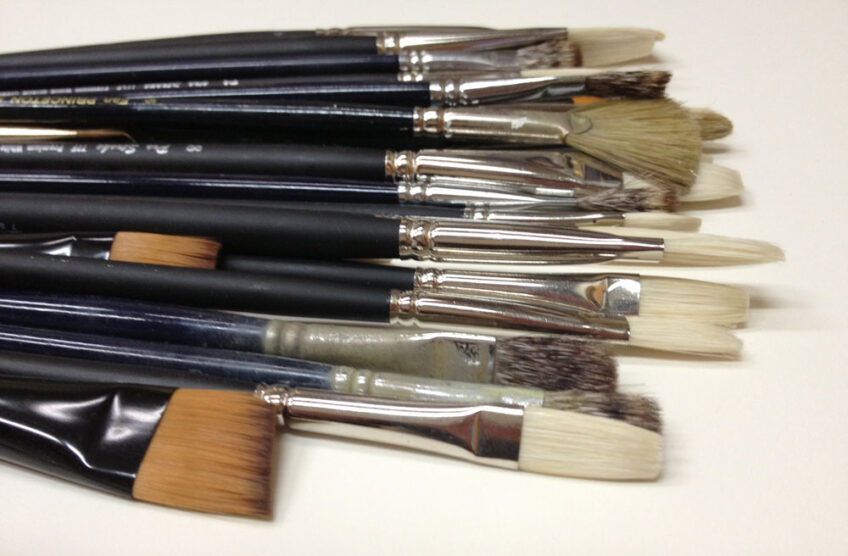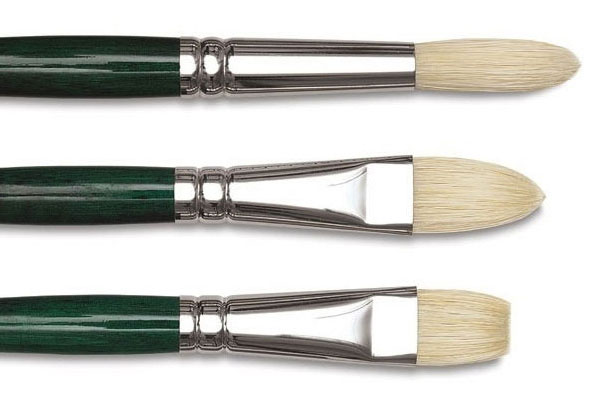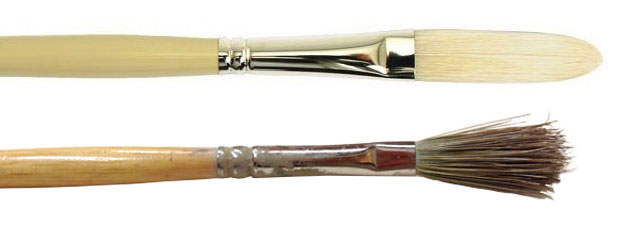How does one go about choosing brushes for oil painting? Perhaps you’ve noticed that the search can be daunting. One visit to an art supply store or online retailer reveals the almost endless brushes from which to choose.
I discovered a few things early in my painting journey that have helped me keep my brush choices simple. Perhaps they can help you too. (It should be noted that I prefer to paint wet-into-wet whenever possible, so that has influenced my brush decisions.)
Stiff vs. Soft
One thing I learned is the difference between stiff bristle brushes and softer synthetic brushes. Bristle brushes offer more durability and can put up with a bit of abuse. They’re great for filling in large areas quickly and for scrubbing, scribbling and scumbling. Softer brushes tend to be more fragile and must be treated with more care. They excel in smooth paint application, glazing and softening effects.
Brush Shapes
I also discovered some things about different brush shapes. And my experience revealed that flat brushes offer a full range of application possibilities without the need for other brush shapes. Using just a flat brush, a painter can make a surprising number of different marks including:
- filling in large areas with the wide flat side
- making thin lines with the long narrow side
- sharply dividing shapes with the narrow flat tip
- making small detail marks with the corners
You may ask, “Don’t you need other brushes like rounds, filberts and brights?” In my opinion, the detail marks that can be made with the corners of a flat brush eliminate the need for a round brush. I don’t need to buy filberts because my flats eventually turn into filberts as they wear down. And brights simply don’t hold enough paint for me and also lack the bounce of longer flat brushes.
My Brushes of Choice
As a result of these discoveries, flat brushes have become my brushes of choice and the majority of my paintings are completed with just two types: the hog bristle long flat and the synthetic long grainer.
Trekell has a brush set available for purchase under my name that contains these brushes I recommend: Dan Schultz Trekell Brush Set.
The Hog Bristle Long Flat
The flat hog bristle is quite versatile. It can hold a lot of paint for thick impasto work or be used to paint thin washes. It has a nice springy quality. For years I used this brush exclusively, but at this point I do about 80% of each of my paintings with long flat hog bristle brushes. I use sizes 2 – 12 in these brushes: Trekell Hog Bristle Long Flats (400LF Series), but occasionally use larger sizes in other brands for larger paintings (my largest is a size 35!).
The Synthetic Long Grainer
The softer long flat brushes I use are synthetic hair that’s made to perform like natural mongoose hair. The softness of these brushes offers the ability to lay down thick paint on top of an already thick stroke without digging into the lower stroke the way the stiffer hog bristle would. They’re also great for softening edges and for detail work. I mainly use these for finishing effects as I approach a painting’s completion. I use sizes 1/8″ – 1/2″ in these brushes: Trekell Legion Long Grainer 9099L series.
Special Effects: Occasionally, I employ a brush called an egbert. It’s an extra long hog bristle filbert that can hold a lot of paint and has an extra measure of bounce. After a lot of use, egberts also develop a ragged character that makes for some fantastic brushwork. I mainly use them for a few final, strategically-placed strokes of thick impasto.
I’ll also occasionally use a palette knife or paper towel for certain effects, but I’m admittedly mostly a brush painter. (Although you’ll often catch me at plein air painting shows touching up paintings with my fingers after I’ve put my brushes away. But I usually end up just getting them out again because I haven’t figured out how to make convincing brush strokes with my fingers.)
Do you have a favorite brush or two to recommend? Leave a comment below!





21 Responses
Rusty Jones
Thanks for the post Dan. Learned something about mongoose brushes being able to pull paint over wet paint. I will give it a try at the first opportunity.
Dan Schultz
Glad it was helpful for you, Rusty!
Julie Evans
Thanks, Dan, this is great! When I was in art school they were more interested in concept than technique. As a result, I learned next-to-nothing about the different types of brushes. (Art supply stores will be disappointed, because I’ve bought whatever someone recommended as the latest-and-greatest. Now my art supply dollars will last longer. hahaha!)
An artist confession- why I am addicted to my Ivory Egbert. | Art Talk
[…] Dan Schultz’s breakdown of his brush choices to see some of the best paintbrush characteristics to look […]
Jim Wood
Thanks for articles like this, Dan. As you know, I am not a painter or an artist of any type, but I am always fascinated to learn and to watch how art is created. I’ll read an article of yours any time!
Dan Schultz
Glad you enjoy the blog, Jim — I appreciate your comments!
Susan Harris
Dan,
Do you think they kill the mongoose to make the brush or just cut it’s hair? Now I have to google mongoose to see what they look like.
Dan Schultz
I actually don’t know how they get the mongoose hair, Susan. But evidently it’s not allowed anymore. The synthetic and badger blend brushes are good replacements though.
Tom Johnston
Hi Dan
Enjoyed your column on brushs. I keep most of my brushs even when they’re worn to a nubin. They come in handy for that special scrumbling effect or to remove extra paint you dont want in the painting and a million other uses. A good use for a round is to buy a cheap one and when you get home take it and distort the brush end to where it’s all awry. Makes interesting bushes. I seen Richard Schmid use a brush with a bad hair day in one of his videos. Keep the great articles coming. Your Friend Tom
Dan Schultz
Thanks for your comments, Tom. There is definitely nothing wrong with using your brushes as long as you possibly can! As I said in the article, I like using those worn, ragged egberts for creating some unique brushwork.
Laurie Hendricks
Thanks, Dan, for the interesting article on brushes! I couldn’t agree with you more about flats (which become filberts) being the main brush one needs! I’ve been wanting to try Rosemary brushes, and now know which one to buy. I always enjoy learning something new, so I really appreciate your blogs. Happy Painting!
Dan Schultz
Glad to be of help, Laurie. Thanks for commenting!
Rob Impellizzeri
Thanks, Dan for excellent discussion on your choice of brushes. I plan to try using my Rosemary badger hair brush to lay down thick paint as you suggest, though I’m curious how you use these brushes for detail work, since they are softly splayed at the end(?).
Dan Schultz
I’m glad you found the article helpful, Rob. Without any paint on the badger hair brushes, they’re very effective at softening edges. But if you have enough paint on the brush, the hairs hold together which is what helps with the detail work. You’ll see when you give them a try.
JOANNE LAVENDER
Hi Dan
Happy you Sarah and the boys are doing well and avoided the recent disasters. I was reading your wet on wet and found myself into the brush info. Without knowing it, you answered my burning questions! Perfect timing. Thanks, joanne
Dan Schultz
Glad to hear it, Joanne! Good to hear from you!
Samai Negrin
This is exactly the info I needed on mongoose vs badger brushes. I’ve been beating myself up about a certain technique I just can’t seem to capture and it turns out it’s been my brush. I have never used mongoose but now I will. Thank you so very much!
MJI
I found this blog while looking for new brushes (the egbert) to add to my collection. I find it amusing what you’ve said about flat brushes vs filbert brushes. My aged flats tend to fan out at the edges rather than turn to filberts, thus I used to go with rounds until I came across filberts. Now I use filbert brushes almost exclusively for most of my painting and seldom use flats.
But then again it could be down to technique and media used. I’m more for for wet on dry, glazing, or painting on 3-D surfaces. As for paint, I go for just about anything. Acrylic is what I use mostly, but I’ll go for oils/ watercolors.
For my painting style, I aim to replicate a natural smooth finish showing very minimal to no visible brush strokes.This wears out a brush fairly fast. Longer brushes eventually turn into brights and brights into blending/ scumbling brushes.
An odd paradox I find is when I have a new brush I’m hyper vigilant to keep it clean and maintain its shape, but once it passes the breaking point when the tips hook over and I can no longer force it to hold its original shape, then I end up enjoying the brush even more than I did when it was brand new. I notice the “hooks” that develop at the end of each worn brush filament also improve blending. Or maybe it’s just that I stop worrying about keeping the brush in a “like new” condition. Who knows.
Dan Schultz
Yes to a certain extent we all develop a certain preference for the particular brushes we use. I suppose once we are able to control the brush and get it to do what we want it to do, the shape doesn’t matter as much. We just end up using what we have available and what we feel most comfortable with.
Jeff
Good info – so many artists recommending a plethora of stuff – thx for simplifying my life!
Jeff
Waltham
Wow, what an insightful perspective on simplifying brush choices for oil painting! It’s fascinating how your preference for wet-into-wet painting has influenced your decisions. The distinction between stiff bristle and softer synthetic brushes is particularly helpful, especially considering their respective strengths in different techniques. Your approach to utilizing flat brushes for a wide range of applications is intriguing—I never thought about the versatility they offer in creating various marks. Thank you for sharing your experiences and insights!